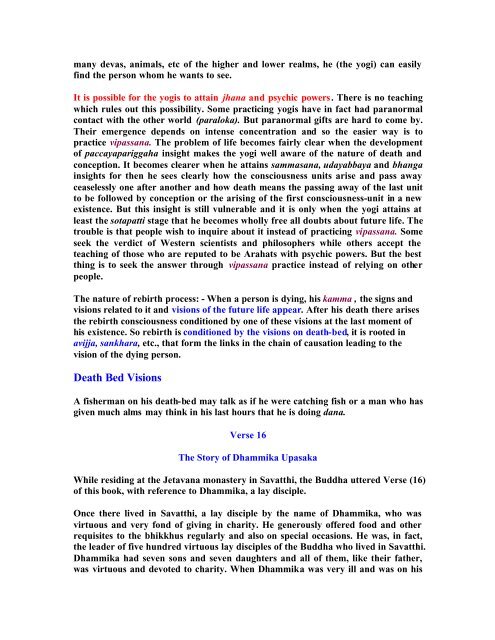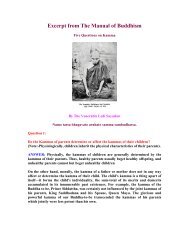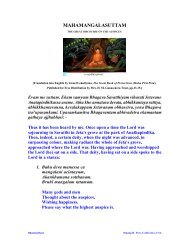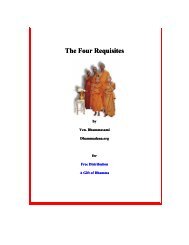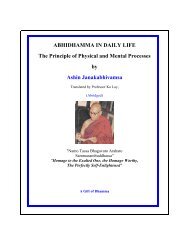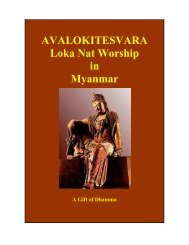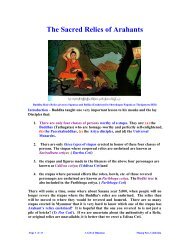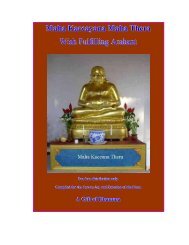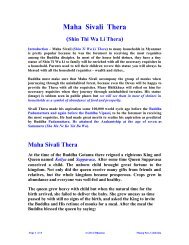Explanation Avija Sankhara-PATICCA ... - Usamyanmar.net
Explanation Avija Sankhara-PATICCA ... - Usamyanmar.net
Explanation Avija Sankhara-PATICCA ... - Usamyanmar.net
You also want an ePaper? Increase the reach of your titles
YUMPU automatically turns print PDFs into web optimized ePapers that Google loves.
many devas, animals, etc of the higher and lower realms, he (the yogi) can easily<br />
find the person whom he wants to see.<br />
It is possible for the yogis to attain jhana and psychic powers. There is no teaching<br />
which rules out this possibility. Some practicing yogis have in fact had paranormal<br />
contact with the other world (paraloka). But paranormal gifts are hard to come by.<br />
Their emergence depends on intense concentration and so the easier way is to<br />
practice vipassana. The problem of life becomes fairly clear when the development<br />
of paccayapariggaha insight makes the yogi well aware of the nature of death and<br />
conception. It becomes clearer when he attains sammasana, udayabbaya and bhanga<br />
insights for then he sees clearly how the consciousness units arise and pass away<br />
ceaselessly one after another and how death means the passing away of the last unit<br />
to be followed by conception or the arising of the first consciousness-unit in a new<br />
existence. But this insight is still vulnerable and it is only when the yogi attains at<br />
least the sotapatti stage that he becomes wholly free all doubts about future life. The<br />
trouble is that people wish to inquire about it instead of practicing vipassana. Some<br />
seek the verdict of Western scientists and philosophers while others accept the<br />
teaching of those who are reputed to be Arahats with psychic powers. But the best<br />
thing is to seek the answer through vipassana practice instead of relying on other<br />
people.<br />
The nature of rebirth process: - When a person is dying, his kamma , the signs and<br />
visions related to it and visions of the future life appear. After his death there arises<br />
the rebirth consciousness conditioned by one of these visions at the last moment of<br />
his existence. So rebirth is conditioned by the visions on death-bed, it is rooted in<br />
avijja, sankhara, etc., that form the links in the chain of causation leading to the<br />
vision of the dying person.<br />
Death Bed Visions<br />
A fisherman on his death-bed may talk as if he were catching fish or a man who has<br />
given much alms may think in his last hours that he is doing dana.<br />
Verse 16<br />
The Story of Dhammika Upasaka<br />
While residing at the Jetavana monastery in Savatthi, the Buddha uttered Verse (16)<br />
of this book, with reference to Dhammika, a lay disciple.<br />
Once there lived in Savatthi, a lay disciple by the name of Dhammika, who was<br />
virtuous and very fond of giving in charity. He generously offered food and other<br />
requisites to the bhikkhus regularly and also on special occasions. He was, in fact,<br />
the leader of five hundred virtuous lay disciples of the Buddha who lived in Savatthi.<br />
Dhammika had seven sons and seven daughters and all of them, like their father,<br />
was virtuous and devoted to charity. When Dhammika was very ill and was on his


